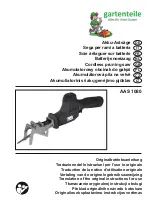
Page 3
0
OPERATION
TO MAKE NON-THROUGH CUTS
Non-through cuts can be made with the grain (ripping) or
across the grain (crosscut). The use of a non-through cut is
essential to cutting grooves, r
e
b
a
t
e
s, and dadoes. This is the
only type cut that is made without the blade guard installed.
Make sure the blade guard assembly is reinstalled upon
completion of this type of cut. Read the appropriate section
which describes the type of cut in addition to this section on
non-through or dado cuts. For example, if your non-through
cut is a straight cross cut, read and understand the section
on straight cross cuts before proceeding.
WARNING:
Unplug the saw to avoid possible injury.
■
Remove the screw holding the throat plate in place.
Remove the throat plate.
■
Raise the saw blade by pushing the bevel locking lever to
the left and rotating the blade adjusting handle clockwise.
■
Put the saw in angle mode by pushing the bevel locking
lever to the right. Turn the blade adjusting handle until the
blade indicator shows a 30
°
angle. Push the bevel
locking lever securely to the left to lock the angle.
■
With the box end of the small hex wrench, loosen the
two hex nuts at the base of the riving knife.
Do not
remove hex nuts.
Remove the riving knife/guard
assembly. Retighten the two hex nuts on the base.
Insert the throat plate.
■
Bring the blade back to 90
°
.
■
Lower the blade to the correct height by turning the blade
adjusting handle counterclockwise. Secure throat plate
with the screw.
WARNING:
Carefully check all setups and rotate the blade one full
revolution to assure proper clearance before connecting
saw to power source.
■
Always use push blocks, push sticks, and featherboards
when making non-through cuts to avoid the risk of serious
injury.
See Figure 42.
WARNING:
Never feed wood with your hands when making any non-
through cut such as r
e
b
at
es or dadoes.
WARNING:
When making a non-through cut, the cutter is covered by
the workpiece during most of the cut. Be alert to the
exposed cutter at the start and finish of every cut to avoid
the risk of serious personal injury.
PUSH BLOCK
Fig. 42
“C” CLAMP
FEATHERBOARD
PUSH STICK
BEVEL
LOCKING LEVER
■
When the cut is made, turn the saw off ( ). Wait for the
blade to come to a complete stop before removing the
workpiece.
■
Lower the blade.
■
Unplug your saw.
■
Remove the screw holding the throat plate in place.
Remove the throat plate.
■
Raise the saw blade.
■
Push the bevel locking lever to the right. Rotate the blade
adjusting handle until the bevel indicator shows a 30
°
angle. Push the bevel locking lever securely to the left
while holding the blade adjusting handle to lock the angle.
Reinstall the blade guard assembly.
■
Retighten the nuts at the base of the riving knife. Check
riving knife alignment to the blade and adjust shims if
necessary.
See page 2
4
.
■
Move the bevel locking lever to the right and rotate the
blade back to 90
°
. Push the lever to the left to lock the
angle.
■
Lower the blade, insert the throat plate, then securely
tighten the throat plate screw.













































